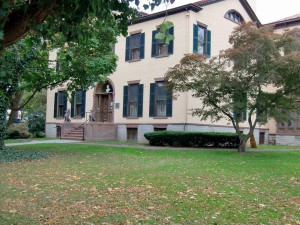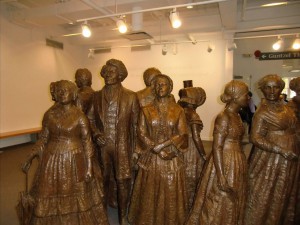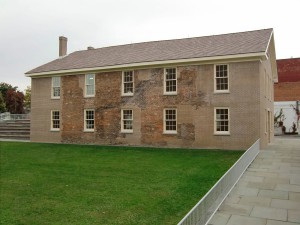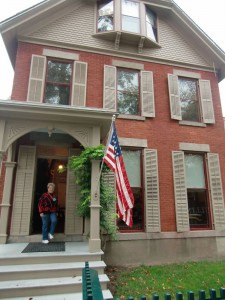EXPLORING NEW YORK – AUBURN AND SENECA FALLS
EXPLORING NEW YORK
This is the eighth in a series of articles about traveling the byways of New York State
AUBURN AND SENECA FALLS
By Charles N. Stevens
Photos by Dolores Seidman
As we greet the day in Auburn, New York, we’re treated to a spectacular sunrise, scattered clouds on fire with bright pink. The red maple outside our window seems to absorb the sunrise and become even redder. Wheeling gulls are silhouetted against the rosy sky. The temperature is 39 degrees. The people in their cars going to work, hunched over their steering wheels, look cold and so do the bundled children in a yellow school bus.
By the time we leave the hotel the breathtaking sunrise is only a memory, the sky now clouded over, mottled and gray. We travel a short distance within Auburn to the former home of William H. Seward, Lincoln’s Secretary of State and probably best known as the man who bought Alaska, the purchase sometimes known as Seward’s Folly. He was a small man, only 5ft. 4 inches tall and weighing 120 pounds, but was powerful and influential. He was very bright and was said to castillo hinchable possess a photographic memory. He helped write the Emancipation Proclamation and survived a vicious knife attack on the same night that Lincoln was shot.
A faint musty smell pervades the air as we enter his home. Most noticeable at first is a grand staircase made of polished manzanita and laurel wood. A dozen or so decorative canes wait in a rack nearby. Many famous people had visited the house, particularly Abraham Lincoln who was here often, even writing some of his speeches in the very room where we stand. It is an amazing feeling to be in a room steeped in so much history.
We pass through a large doorway, the pocket door sliding smoothly into the wall, then step into his library. Shelves of old books reach to the wooden ceiling. He and his wife were avid readers, and it is said that there are 8,000 books in the house.
In the dining room with its white ceiling and its red fabric-covered walls, the table is set for dessert as though his guests are ready for the last course. A huge punch bowl with cups dominates the table. Seward loved gatherings and parties and so had had them often in his home.
The parlor contains more books, a large Turkish rug and a piano. Paintings adorn the walls, and on a small table rest a stereopticon and a mah jong set.
But most interesting is his basement where he hid runaway slaves when Auburn was a stop on the Underground Railway. He also helped Harriet Tubman, a leader in that movement, to settle in Auburn.
Seward’s wife, Frances and daughter, Fanny, worked with Elizabeth Cady Stanton of nearby Seneca Falls to further the cause of women’s rights.
We’re on our way now to Seneca Falls, home of the Women’s Rights National Historic Park. Clouds dull the sharp colors of the landscape. Geese flying south draw a huge “V” against the lowering sky.
As we enter the brick building housing the Women’s Rights Museum, we are greeted by eleven life-sized bronze statues of the leaders of the women’s movement. Among them is Elizabeth Cady Stanton, one of the pioneers of the movement, and the abolitionist, Frederick Douglass. Stanton once said, “We hold these truths to be self evident; that all men and women are created equal.” Although her home still exists in Seneca Falls, we do not have time to see it.
Upstairs are many professionally done displays chronicling the development of women’s rights from the beginning of the movement to their attaining the right to vote. Next door to the museum stands the Wesleyan Chapel where 300 men and women gathered in 1848 for the First Women’s Rights convention —wanting change and political action.
As we leave the museum raindrops dot the sidewalk. On the bus again, we roll through the small town of Waterloo where the idea for Memorial Day began. Back on Interstate 90, our bus is bound for Rochester.
In a light rain we drive into what was once a middle class neighborhood in suburban Rochester to visit the former home of Susan B. Anthony. A Quaker, she believed in the equality of all people, including women. Even though her two-story house is modest, it is of great historic significance. Susan B. Anthony was an ardent abolitionist. She also argued for co-education, claiming that there is no difference between the minds of men and women. She championed the eight-hour work day and equal pay for equal work. She is better known for her demand that women have the right to vote and was arrested because of her protests.
Again, it is strange to walk through a house where so much history has occurred. Most interesting is the attic room or “raised roof” where her offices were. In the room is her alligator handbag, a red shawl and one of her black dresses. She was quite tall with an imposing stature. Her office today looks much as it did when she lived here, a large photo showing how it was then. The shelves and tables are the same, her papers and books gone. We are told that 10,000 people attended her funeral procession in Rochester.
Outside, sitting on the bus, I look back at he house, a brick structure with cream-colored shutters and a high peaked roof. Fallen leaves cling to the wet sidewalk. An American flag on the portico hangs limp as I listen to the patter of raindrops on the bus roof.
I think about what it was like for the woman who lived in this house, the tension she endured. When it was illegal for women to vote, she and several other women registered anyway. That November they challenged the law by voting. A federal marshal arrived at her door and arrested her, taking her to jail. At her trial the judge fined her $100—a fine she refused to pay.

Lincoln often visited the home of William Seward, his Secretary of State, in Auburn.

In the Women's Rights Museum in Seneca Falls stand the giants of the Women's Movement.

The First Women's Right's Convention was held in The Wesleyan Chapel in l848 in Seneca Falls.

We visited the home of Susan B. Anthony in Buffalo, New York.



